Урок з англійської мови "Food" 10 клас
Theme: Food. Second Conditional
Form: 10
Main aims: to learn the usage of Second Conditional, to enlarge vocabulary on the topic
Subsidiary aims: to improve listening and speaking skills
Teaching aids, materials, equipment: computer, projector, screen (interactive teacher’s place), O.Karpiuk “English 10”, CD-player
|
Timing |
Procedure |
Subsidiary aims |
Aids |
Interaction pattern |
|
3 m |
Warm up |
Getting ready for the lesson |
Computer, projector, presentation |
T-Ps |
|
10 m |
Speaking Practice |
Improving speaking skills |
Computer, projector, presentation |
T-Ps |
|
7 m |
Listening Practice |
Improving listening skills |
CD-player |
P1-P2-P3 |
|
5 m |
Break |
Having rest |
Notes |
|
|
18 m |
Grammar Practice |
Learning and practicing the use of the Second Conditional |
Computer, projector, presentation |
T-Ps P1-P2-P3-P4 |
|
2 m |
Summing up |
Making conclusions, grading, giving home task |
|
|
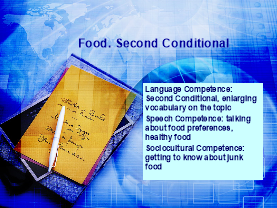
I. Getting ready for the lesson
1. Greeting, setting aims
Good morning, ladies and gentlemen. Take your seats and get ready for the lesson. Today we’re going on talking on the topic Food; we are to revise the words we’ve learnt, learn some new ones, and develop our listening and speaking skills. The main aim of our lesson is a grammar topic. It is the Second Conditional.
2. Warm up
To begin with, let’s remember some important things about British meals. 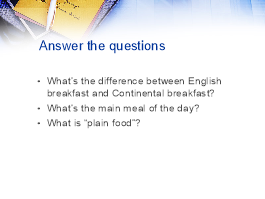
You are to answer the questions you see on the screen.
II. Main part
1. Speaking Practice
Let’s speak about healthy and unhealthy food.
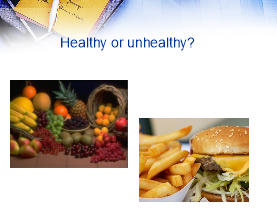
Which of these foods are healthy and which are unhealthy?
I’m going to present you a new term “junk food”.
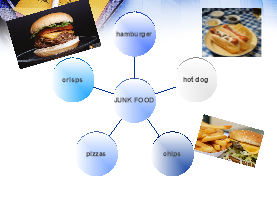
Junk food is high in calories and saturated fat and lacking in nutrition.
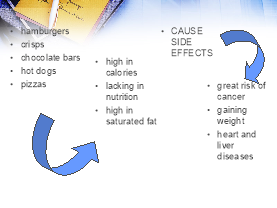
That’s why it may cause such side effects as a greater risk of cancer, gaining weight, heart and liver disease.
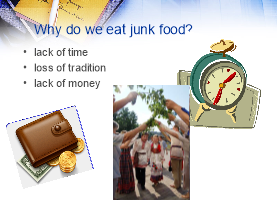
Why do we eat junk food? –that is the question. (Pupils try to give their own reasons). The answer is because of lack of time and loss of tradition.
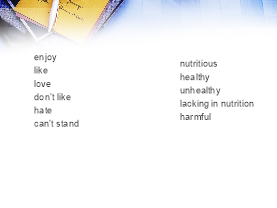
And now, please, express your opinion about junk food.
Let’s make a conclusion

You know that almost every country has its own cuisine and what is more some popular dishes are associated with this or that national cuisine. We’re to remember such dishes.
Your task is to complete the sentences.

Pudding is a typical English/British dish.

Pizza is a typical Italian dish.
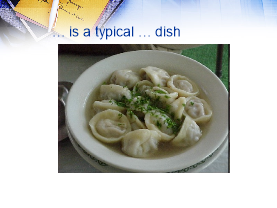
Pelmeni is a typical Russian dish.
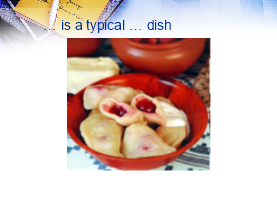
Varenyky is a typical Ukrainian dish.
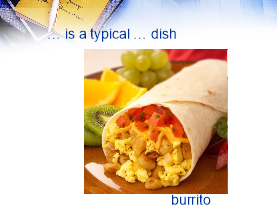
Burrito is a typical Mexican dish.
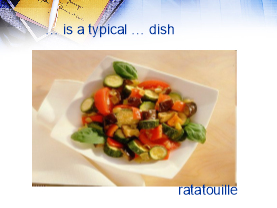
Ratatouille is a typical French dish.

Sushi is a typical Japanese dish.
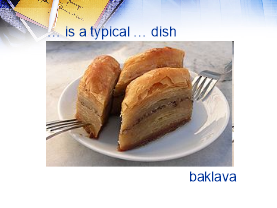
Baklava is a typical Turkish dish.
That’s great.
2. Listening Practice
Are you interested in celebrities’ private lives? Do you know much about their food preferences? Let’s listen to the text find out what the stars like eating.
On the screen you can see the names of some film stars and the dishes they like. Your task is to match the columns.
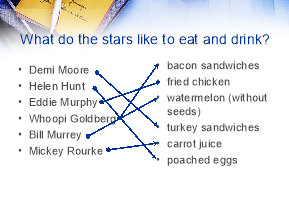
Thanks a lot. You’re so hard-working today.
3. The break
What about having a break? I want to make a Christmas pudding but have no ingredients for it. Would you be so kind to help me? Find the ingredients for our pudding and put them into this bowl. (The pupils bring the sheets of paper with typed words).
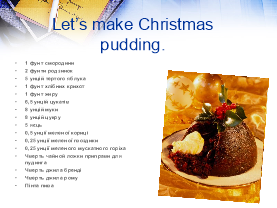
Thank you very much. I hope my pudding will be delicious.
4. Grammar Practice
As I have said at the beginning of the lesson we’ve got some new grammar today. It is the continuation of the topic Conditional sentences. Let’s remember some things about them.
How many types of conditional sentences do you know? (3 or 4)
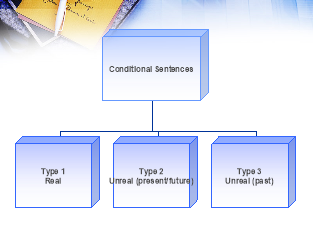
One of them you already know. It’s the First Conditional (Real condition). How many parts does a conditional sentence consist of? What are they? In what order do they go?
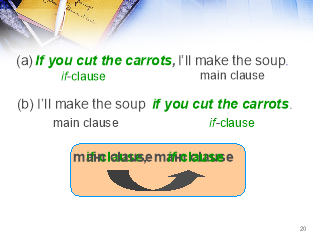
What tenses are used in the First Conditional?
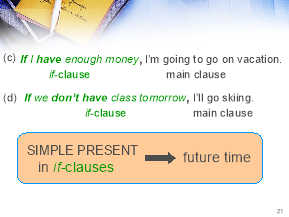
Let’s get acquainted with the Second Conditional. Here is the conversation that took place between Winston Churchill, a British politician and statesman, and Nancy Astor, the first woman to sit as a Member of Parliament, at a dinner party:

Are these conditional sentences real? What time do they refer to: past or present? What tenses are used in these sentences? (Pupils try to answer the questions.)
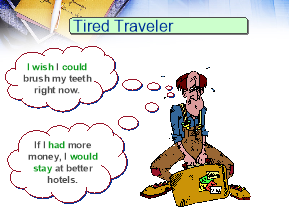
Let’s study some more examples.
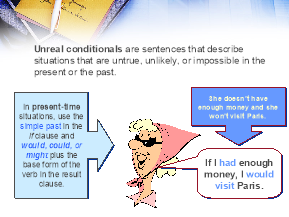
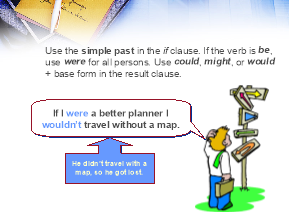
Let’s sum up and make our know-how of the Second Conditional.

We know the theory quite well so it’s high time to do some exercises.


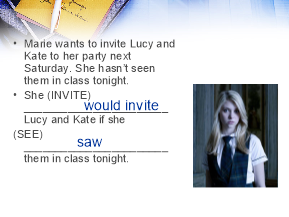
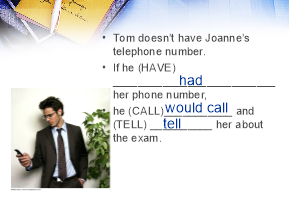
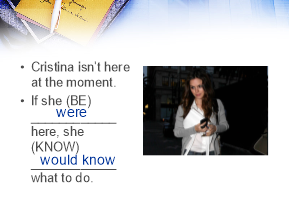

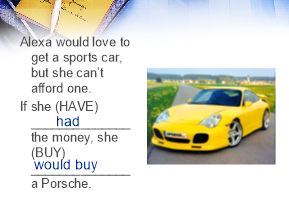
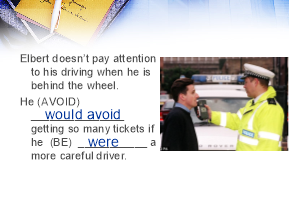
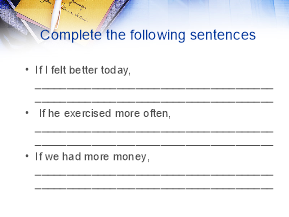
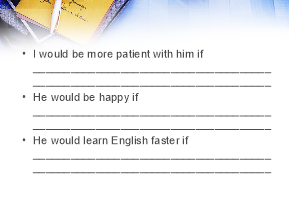
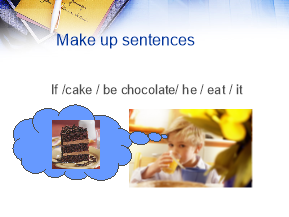
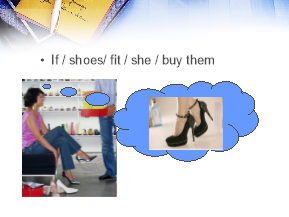
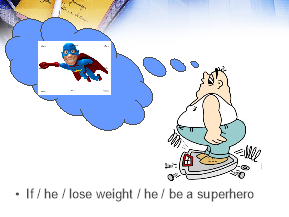
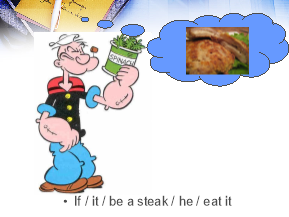
If there’s some time left you can watch a clip (either The Beatles “In an Octopus’s Garden” or Beyonce “If I Were a Boy”).
Asking questions about the Second Conditional.
III. Summing up the lesson
You have been working hard and your marks are…
Your home task for the next lesson is __________
|
black current |
raisins |
|
apple |
bread crumbs |
|
beef fat |
candied fruit |
|
flour |
sugar |
|
cinnamon |
cloves |
|
nutmeg |
pudding flavoring |
|
brandy |
rum |
|
beer |
eggs |


про публікацію авторської розробки
Додати розробку
